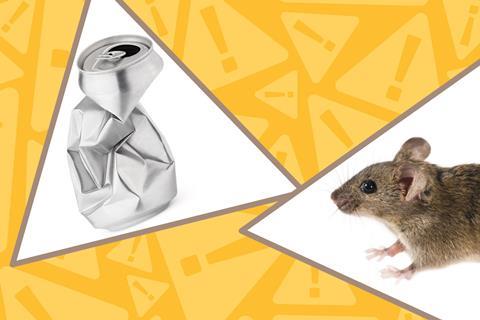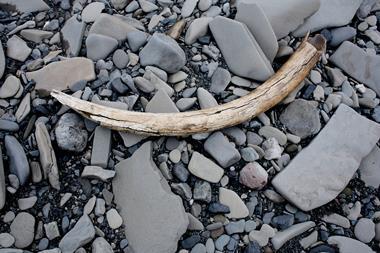How to test illicit substances at festivals and identify the rodent in your beer
Brew clues

Hot weather prompts many to reach for a ‘cold one’, whether light lager or a summer stout, from standard ABV to alcohol free. Drinkers expect seasonal taste profiles in their summer brews, with flavours complementing everything from peaceful beach lounging to rollicking festivals. What no imbiber expects is a pest in their Pilsner. Discomforting discoveries of rodent remains in a beer have been reported, with even the tiniest critter prompting a large-scale investigation.1–3
Rodent contamination of food and drink isn’t simply unpleasant – it’s a significant public health concern. When a rodent incursion occurs, identifying the exact species and where it entered the supply chain are critical steps toward preventing future incidents and improving food safety.
Investigators use complementary techniques to pinpoint supply chain pest problem areas, as recently detailed in a paper by researchers in the University of Wisconsin–Madison’s department of forest and wildlife ecology in the US.1 A New Jersey consumer reportedly encountered a rodent in a beer originally canned at a facility in Dallas-Fort Worth (DFW), Texas. The researchers were able to suss out the rodent’s species and territory by sight, genes and isotopes.
Video of the rodent’s removal from the can and post-removal rodent images showed it was ‘surprisingly intact’. The researchers scrutinised the images, with the rodent’s morphological features pointing clearly to the mouse genus Peromyscus. Determining the rodent’s species also reveals its range, which can rule in or rule out where a rodent entered the supply chain. Of the nine species of Peromyscus, New Jersey only hosts P. leucopus (white-footed mouse), while DFW is home turf to both P. leucopus and P. maniculatus (deer mouse).
With mouse tissue and hair samples in hand, researchers set out to speciate the mouse. They used mitochondrial DNA analysis featuring species-specific primers to identify the beer dwelling mouse with high accuracy as P. leucopus. So to localise the mouse to DFW or New Jersey, researchers turned to stable isotope analysis.
Isotope analysis is a powerful investigative tool, enabling scientists to determine provenance in a wide range of cases to help identify people, wildlife and artifacts.1,3–6 In the mouse case, researchers determined the isotopic composition of hydrogen (δ2H) and oxygen (δ18O) values of prepared mouse hair samples using an isotope ratio mass spectrometer–continuous flow thermochemical elemental analyser. Varying levels of precipitation along geographic gradients means scientists can use δ2H and δ18O values to locate the origins of human and wildlife remains.
Mapped geographic precipitation data and the P. leucopus’ δ2H and δ18O values, along with careful statistical work, prompted researchers to assign the putative origin of the mouse to New Jersey. As further support for this location, previous research into the rate of rodent decomposition in beer has shown it occurs rapidly. Thus the noted ‘surprisingly intact’ condition of the mouse indicated the time spent in beer was short.1,2
By employing multiple techniques, researchers showed it was unlikely the white-footed mouse did the Texas two-step into a can of beer.
Music festival insights
From England’s Glastonbury to Mexico’s Baja Beach Fest to Japan’s Fuji Rock, the popularity of summertime music festivals means a near global dance party. Drugs with more complicated legal statuses than beer pop up at festivals.7–9 Many venues offer ‘amnesty bins’ to offload illegal drugs and other prohibited materials without fear of censure.10 While some festivalgoers discard drugs to dodge possible charges, others do so because of adulteration concerns.
Analysing the suspect drug samples found in amnesty bins can reveal drug and adulteration trends, providing critical information to a wide array of professionals – from investigators probing drug trafficking to healthcare experts seeking the best care of community members.10–12 These aims can be met via the development of robust, reliable and field ready instrumental methods such as one recently detailed in the Journal of the American Society for Mass Spectrometry.10
A multi-institutional UK team studied the use of a single quadrupole mass spectrometer combined with an atmospheric pressure solids analysis probe (MS–ASAP) for both onsite and offsite analysis of suspect drug samples. Researchers targeted commonly encountered drugs including MDMA, cocaine and ketamine, though other drugs present in the samples also tested their method.
Hundreds of samples collected from three summer music festivals in the UK between 2021–2023 were analysed using MS–ASAP and/or an established laboratory-based gas chromatography–mass spectrometry (GC–MS) method. Compound library matching and scoring was performed for each method. Selectivity is an area of evaluation for new methods; while MS–ASAP struggled on that front, researchers calculated it still produced correct results in 93% of onsite and 92.5% of offsite tests.
The MS–ASAP method shows promise as a rapid and reliable way to qualitatively test suspect drug samples in the field or lab. The beats can go on even safer than before.
References
1 J N Pauli and M Rodriguez Curras, Forensic Sci. Int.: Anim. Environ., 2024, 5, 100081 (DOI: 10.1016/j.fsiae.2024.100081)
2 M C Williams, Forensic Sci. Int., 1996, 82, 211 (DOI: 10.1016/s0379-0738(96)01998-6)
3 E J Bartelink and L A Chesson, Forensic Sci. Res., 2019, 4, 29 (DOI: 10.1080/20961790.2018.1549527)
4 M P V Matos and G P Jackson, Forensic Chem., 2019, 13, 100154 (DOI: 10.1016/j.forc.2019.100154)
5 W Meier-Augenstein, Stable Isotope Forensics: An Introduction to the Forensic Application of Stable Isotope Analysis. John Wiley & Sons, 2011
6 N Gentile et al., Forensic Sci. Int., 2015, 251, 139 (DOI: 10.1016/j.forsciint.2015.03.031)
7 T Mackuľak, et al., Sci. Total Environ., 2019, 659, 326 (DOI: 10.1016/j.scitotenv.2018.12.275)
8 J Fox et al., Subst. Use Misuse, 2018, 53, 1203 (DOI: 10.1080/10826084.2017.1400067)
9 A Healey et al., Drug Alcohol Rev., 2022, 41, 320 (DOI: 10.1111/dar.13404)
10 A Frinculescu et al, J. Am. Soc. Mass Spectrom., 2024, 35, 1480 (DOI: 10.1021/jasms.4c00064)
11 A Frinculescu et al, Drug Test. Anal., 2024, DOI: 10.1002/dta.3629
12 J D Ramsey et al., BMJ, 2001, 323, 603 (DOI: 10.1136/bmj.323.7313.603)

















No comments yet